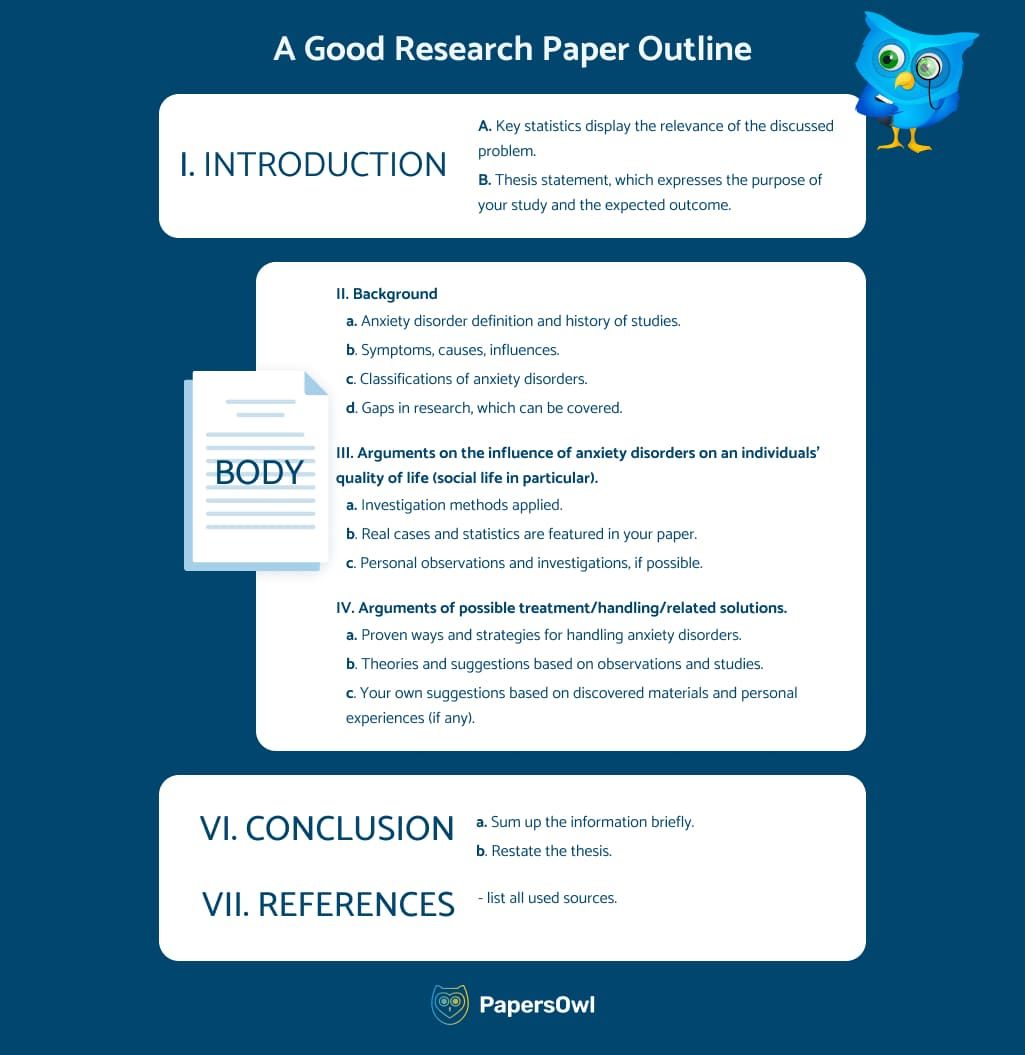Research Paper Outline: Designing Your Research Narrative
Table of contents
Student research paper outlines sound complicated, especially when unsure about the topic. A well-organized outline can provide a clear roadmap to guide you through the research process.
In this article, you will discover how to make a research paper outline quickly and effectively. These steps will streamline your research and creative process. It will ensure cohesive and compelling writing, from the thesis statement to the afterword.
This article delves into the essential aspects of crafting a research paper outline, a foundational tool in academic writing.
- We will explore its primary purpose, providing a research paper outline template to help you stay focused.
- The key components of a research paper outline include formatting with Roman numerals, maintaining a parallel structure, and choosing the proper citation style.
- Additionally, we’ll offer insights into balancing the outline’s length and detail to meet assignment requirements. We’ll give some practical tips for refining your research paper outline.
Keep reading and find the answers to the most complicated questions about your academic research. Following our advice will give you a high-quality and robust outline for your research paper.

Key Components of Research Paper Outline
A clear and organized plan is essential for a good research paper outline. This plan will help you stay focused and ensure your paper is well-structured. If you need help, you can ask online research paper writer for assistance.
Research paper outlines can be formal or informal.
Formal ones are typically submitted to professors during the early stages of writing.
Informal outlines serve as drafts where students jot down their initial ideas.
Thesis statements summarize the main subject and ideas of your paper. They appear in the first paragraph and tell your reader what you’ll discuss. Thesis statements also define the specific focus of your essay and what your reader can expect.
Title page
The title page of a research paper outline provides essential information about the work. It typically includes the following for an APA outline template:
- Title. A concise and informative statement that accurately reflects the content of the paper.
- Author’s Name. The name of the individual who conducted the research and wrote the paper.
- Educational Institution. The name of the university or institution where the research was conducted, if applicable.
- Publication Date. The date the paper was completed or submitted.
The title page serves as the first impression of the paper, offering readers a brief overview of its content and authorship. It is crucial to ensure that the title page is formatted correctly and includes all necessary information.
Abstract
The abstract of a research paper serves as a concise summary of the essential findings and their relationship to previous research. It should be written clearly and concisely, highlighting the most important ideas presented in the study.
A well-crafted abstract should:
- Provide an overview;
- Pique the reader’s interest;
- Encourage them to dive into reading the paper.
Introduction
The introduction of a research paper outline should provide essential background information. It sets the stage for the central argument. The introduction also puts topics in context, explaining their significance. Use the same writing style for your research question as you introduce the main point. If it is MLA style paper, remember about relevant academic standards.
This part should spark the audience’s curiosity and motivate them to keep reading.
Body Paragraphs
They form the backbone of your research paper and an APA outline. As you write a research paper, this is the place to present your arguments, evidence, and analysis. Each paragraph should focus on a specific point related to your thesis statement. A typical APA format or MLA outline will require at least three body paragraphs. Add all major points and all the ideas that you have for a chosen research topic.
Critical elements include:
- Topic sentence, which sets the tone and the main point.
- Supporting evidence, which provides facts, statistics, and quotes.
- Analysis, which explains how the evidence supports your thesis. A literature review may be necessary when you write a research paper.
- Transition: Connects the paragraph to the previous one and sets up the next for the entire paper.
Conclusion
Restates the argument, reaffirming the study’s importance and relevance. It should convey that the research has achieved its mission and summarize key takeaways. All research findings must be based on existing research. Any further research recommendations may be included as you create outlines.
References/Bibliography
Lists all cited works, encompassing both directly quoted and paraphrased sources. Adherence to a specified formatting style (e.g., MLA format research paper outline, APA research paper, Harvard research paper format) is crucial.
Additional Resources
Incorporates additional elements such as tables, charts, figures, and specialized terminology. These additions enhance the presentation of data and help a deeper discussion of the topic. Use good logical structure and supporting details as you stay focused on your main point. Remember to use a full sentence format in your explanations.
Research Paper Outline Example
A research paper outline lists key points and sub-topics you want to cover in your writing. It will help you structure your essay and ensure you cover all the information you need to include.
To put this into practice, here is a short research paper outline example of Healthcare.
Example: The Cases of Autism in Georgia State
I. INTRODUCTION
A. Definition of autism
B. Rise in autism cases in recent years in Georgia State, USA.
C. Details of figures with examples.
II. DANGERS OF AUTISM
A. Symptoms and timeframes of autistic spectrum.
B. Risks and precautions.
C. How widespread is autism in Georgia
III. PREVENTIVE MEASURES AND RECENT RESEARCH
A. Link of immunization to autism.
B. Autism debates and social stigma.
IV. CONCLUSION
A. Summary of research arguments.
B. Summary of figures and examples.
C. Concluding statement based on gathered data.
D. Recommendation.

If you still have hesitations or doubts, PapersOwl writers will gladly assist. Get your “A” today by using this article as an example (and maybe inspiration) for future research assignments!
Critical Components of Research Paper Outline
Creating a research paper outline is an essential part of academic writing. It usually has three parts: a draft, a list of sources, and an abstract. The outline should include all the essential parts of your paper to make it well-organized and complete.
Here’s what to include for an initial outline draft:
| Section | What questions does it answer? |
|---|---|
| Introduction | What is your research area? What research papers did you read before choosing your topic? |
| Methods | What methods, questionnaires, and tests did you use in your research? Are these methods commonly used in your field, or must you explain them in more detail? |
| Results | What did you achieve? How can you visualize it? (it’s vital to draw infographics, tables, or diagrams in this section) |
| Discussion | Do your findings apply to everyone or only to a specific group? Could your research be helpful for people in other jobs or fields? |
| Conclusion | Rearrange your notes and fill in the missing parts. You can do this on your computer or paper. Review your outline once you’ve used all your notes to see if anything is missing. Use full sentence method to explain things. |
Make Your Research Paper Outline Effective
Creating an effective research paper outline is not fast. It requires a focus on detail and adaptability. There is no basic template to generate a successful thesis statement or body parts. Yet, it must be specific. Here are some tips to enhance your outline-writing skills:
- Frequent Revisions. Treat your research outline as a dynamic document with main ideas. Frequently review and revise it as your research advances and your comprehension deepens. This iterative method guarantees that your plan stays in sync with the evolving structure of your research paper. Try to achieve a full sentence as you write and follow a decimal format if possible.
- Be Specific. Add specificity to your topic outline for the research paper and a problem statement. It is an essential step! Talk about practical applications, especially when citing sources. Accordingly, begin a research paper with the main idea. Precisely express the primary concepts in each section, strengthening them with relevant particulars.
- Detail or Conciseness. Strive for a balance between detail and conciseness. That is why adding sufficient information to guide your writing is crucial. Avoid loading your research paper outline with unnecessary details. Consequently, it should focus on the key elements to maintain clarity and coherence.
- Be Flexible. Adapt if discoveries or information arise, and be flexible enough to alter the outline accordingly. Flexibility enables your outline to adjust to the nature of the research journey.
By following these tips, you can create a solid research paper outline. Don’t forget to revise your outline to ensure it’s clear and well-organized.
How to Style Research Paper Outlines
There are several standards you need to consider when formatting. Have you written everything according to the APA research paper outline style? Look at the research paper format numbering.
Visual arrangements complement the outline format, especially for a decimal research paper outline. It helps you organize your thoughts and create a clear structure. Here are some things to keep in mind as you challenge this daunting task:
Roman numerals, letters, and numbers. Use Roman numerals (I, II, III) for main alphanumeric outline sections, capital letters (A, B, C) for subsections, and Arabic numerals (1, 2, 3) for further divisions. This tiered structure visually arranges the outline, offering a guide for the reader. This way, you create an alphanumeric research paper outline. If you are unsure about how it’s done in research work with Arabic numerals or page number placement, see MLA guidelines at your institution.
Maintain a consistent structure. Guarantee grammatical structure and formatting uniformity across the outline, heightening readability and coherence. Thus, it will foster an easier comprehension of the progression of your ideas. The use of a good hierarchical structure is a good idea for a research design in social sciences.
Select a citation style. Select a specific citation style as per the requirements set by the professor. For example, the teacher tells you to use a research paper outline in Chicago style. Common styles include APA format, MLA (Modern Language Association) style, Chicago, and others.
Be consistent with your grammar and follow a specific citation style. Use complete sentences and follow basic format guidelines. This will show your adherence to the academic rules. Balancing detail and clarity is critical when writing a research paper outline. Some assignments need a very detailed outline, while others can be shorter.
If you need help with a decimal outline, you can purchase a research paper online from a professional writer.
Where to Find the Research Topics for High School Students?
When selecting research topics for high school students, consider your interests, current events, and academic areas. These strategies can help you find an engaging and meaningful topic.
Consider these areas for your research paper outline and remember when to use lowercase letters for a particular outline format:
- Science and Technology;
- History and Social Studies;
- Literature and Language Arts;
- Psychology and Sociology;
- Arts and Humanities.
Don’t forget about medicine. Unless you live on another planet, exploring topics for medical students will always be in high demand. Consider delving into the fascinating world of emerging medical technologies, such as artificial intelligence in healthcare, gene editing, or nanomedicine.
If you’re interested in public health, you could explore global health disparities, infectious diseases, or mental health. For those passionate about clinical research, consider investigating the latest advancements in cancer treatment, rare diseases, or regenerative medicine. You can check
Here are more ways to start writing and find engaging discussions for your outline format with all the main points:
Academic Database
High school students can explore reputable databases like JSTOR, Google Scholar, or EBSCOhost to find research paper topics using academic databases and articles. It is essential for an APA outline as it helps to find relevant information and work with related evidence. They can also search for relevant keywords related to their interests or potential research areas to narrow their search results.
Read article abstracts to determine relevance, analyze the methodology and findings, and identify potential research gaps. Following these steps, high school students can discover interesting and informative topics based on the latest academic takeaways.
Personal Experience
Take some time to think about the topics that genuinely interest and engage you. What subjects do you enjoy discussing with others? Are there any areas where you feel passionate about making a positive change? For example, if you believe your school could be more inclusive, you could develop a business plan outlining strategies to promote diversity and equity.
By reflecting on your interests and identifying areas for improvement, you can find research topics that are both personally meaningful and impactful.
Rely on Trends
To find engaging and relevant research topics, it’s essential to stay informed about the latest trends and developments in the world:
- Stay updated by subscribing to newspapers, magazines, and online news outlets.
- Follow news organizations, influencers, and thought leaders on social media.
- Participate in online forums and comment sections to understand conversations around different topics.
- Look out for emerging issues on the news.
- Analyze how recent events shape public opinion, influence policies, or affect society.
By staying updated and actively engaging with the information you encounter, you can discover a wealth of timely and relevant potential research topics.
Teachers and Counselors
Contact your teachers and guidance counselors and get recommendations for writing a research paper outline. They can leverage their knowledge of your academic strengths, interests, and coursework to suggest potential topics that align with your goals and abilities. Additionally, they may be aware of specific research opportunities or projects within your school that you could explore.
Online Topic Generators
Exploring these resources allows you to discover an intellectually stimulating and meaningful research paper topic. Engaging with academic databases, news sources, and personal interests will allow you to find a topic that aligns with your passions and curiosities. This will lead to more substantial supporting elements in your list of references.
Communication Rules in Research Paper Outlines
Use clear and consistent language to receive a high grade for your research paper outline. Try to utilize the same grammatical form for all points and sub-points. For example, if the first point is a verb, all sub-points should also be verbs. The same works for capitalization: if you capitalize the first bullet, apply the same formatting to the rest.
Make sure all your points are equally important. For example, the subheadings should have the same level of importance as all first sub-points, second sub-points, and so on. Plus, make the main headings sound general and the smaller ones more specific.
Final Words
Creating a research paper outline is essential for a streamlined writing process. This guide emphasizes the importance of ongoing edits, subpoint clarity, and conciseness. You will find a research paper outline template, APA paper outline, and some tips here. Your research’s progress ensures its continued relevance and usefulness.
A well-structured research paper outline serves not only as a roadmap but as a helpful tool, facilitating the transformation of ideas into a coherent and impactful research paper. As you embark on this intellectual journey, recognize that the thoughtful construction of your outline is not just a precursor; it’s a dynamic foundation shaping the trajectory of your scholarly contribution.






